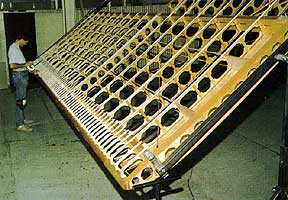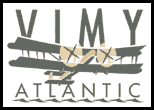Building the Vimy:
Part II: Zen and the Art of Aircraft Building
by Miles McCallum
John La Noue was taken on as Chief Engineer and contracted
to build the wings and complete the airplane, despite
having had little to do with aviation. His initial reaction
was "Now, that's a challenge." His enthusiasm
and excitement at re-creating one of the world's most
historically significant aircraft was only outshone by
Peter McMillan, a man most definitely touched by the romance
of early flight.
 John
La Noue's first task was to find materials to build the
wings: 330ft of box spars would have to be built, as well
as 100 complex ribs, many measuring over 10ft long apiece.
The design called out for Sitka Spruce and aircraft quality
Birch Ply. Birch Ply can be readily obtained from Finland,
but little aircraft grade Sitka is available in such huge
sizes nowadays — quite a few parts needed to be 22 foot
long. As an alternative, Douglas Fir was proposed. It's
heavier but stronger, and plenty of the required quality
is available. John
La Noue's first task was to find materials to build the
wings: 330ft of box spars would have to be built, as well
as 100 complex ribs, many measuring over 10ft long apiece.
The design called out for Sitka Spruce and aircraft quality
Birch Ply. Birch Ply can be readily obtained from Finland,
but little aircraft grade Sitka is available in such huge
sizes nowadays — quite a few parts needed to be 22 foot
long. As an alternative, Douglas Fir was proposed. It's
heavier but stronger, and plenty of the required quality
is available.
The trade-off of weight against a better margin of safety
was accepted. Nearly 3000 board feet of fir was hand selected
from commercial sources and then — using a 330 page US
Army/Navy publication issued in 1944 — subjected to a
rigorous inspection.
 In
addition to building the airplane, the team had to build
all the tooling, fixtures, fittings and jigs, as well
as reinvent long forgotten skills or dream up modern solutions
to problems. Time and finances dictated construction methods
— both being limited. As John later commented: "We
developed a Zen-like approach to our work. Do it once,
do it right, no wasted motion, no going backwards." In
addition to building the airplane, the team had to build
all the tooling, fixtures, fittings and jigs, as well
as reinvent long forgotten skills or dream up modern solutions
to problems. Time and finances dictated construction methods
— both being limited. As John later commented: "We
developed a Zen-like approach to our work. Do it once,
do it right, no wasted motion, no going backwards."
The spar caps (horizontal elements of the box spars),
for instance, required eight pieces of fir measuring 4
in by 24 ft to be laminated. To apply even pressure during
gluing, a fixture was made that allowed eight sections
to be done at once (in fact, 16 sections — after cure they
were sawn into 2in wide blanks for milling). It was essentially
a long, very strong, U-channel; four glued spar cap sections
were placed in each side of the fitting, and a firehose
run between them. Inflated by compressed air, it applied
an even 100psi while the glue cured.
A similar but inverted scheme was used for the spar webs,
the vertical elements of the box spars. Comprising of
ply faces sandwiching a ladderwork of compression blocks,
these were glued on a vacuum table. Here, the glued up
components are laid on a perforated table and covered
with a thick vinyl sheet taped to the table edges. All
the perforations are connected to a powerful vacuum pump
and, when switched on, it acts like an 11-ton press using
atmospheric pressure.
There was nothing complicated about the design or unusual
in the construction methods. It was just the sheer scale
of the aeroplane that was daunting. With a wingspan nearly
twice that of a light single, the wing area is eight and
a half times that of Cessna 152. The empty weight — a
good measure of materials that went into the project —
totals just under 8000 lb.
© Miles McCallum 1997, 1998.
Photos by Matthew Rebholz show the Vimy under construction.
| 

